TRENDING IDEAS IN TECH DÉCOR
June 2017 | By Hala Bissada, CFRE
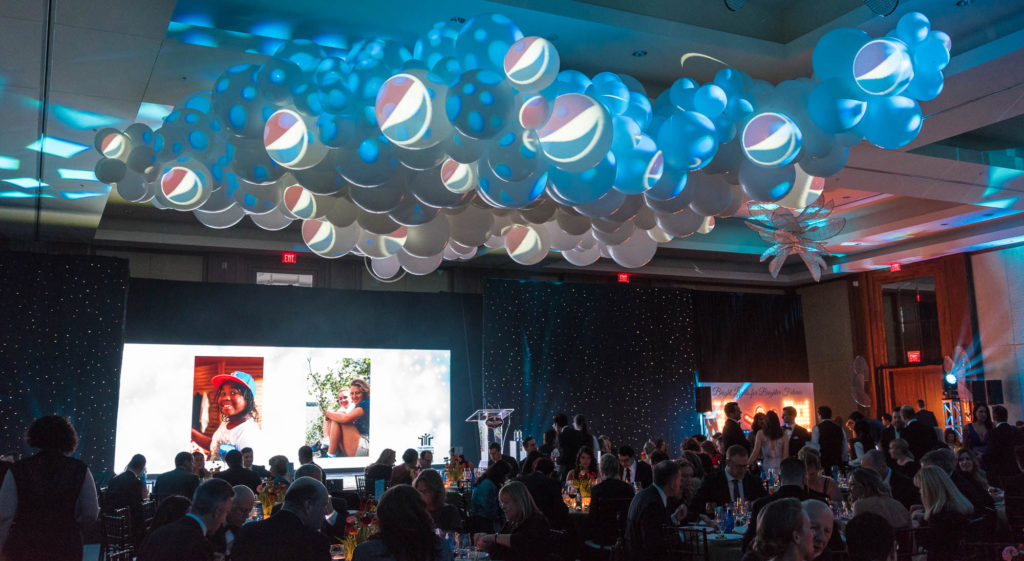
USING CREATIVE TECHNOLOGY TO ENHANCE YOUR EVENT ENVIRONMENT
We as event planners are constantly faced with the challenge of having to create bigger and better experiences but we are told to stay within the same budgets or sometimes even less. Knowing how to anticipate what lies ahead, and what new live event technologies are available is key to your success and establishing yourself as a knowledgeable industry leader. Without a doubt technological advancements in projection and lighting have enabled us as event designers to think outside the box and create truly immersive environments to marvel our audiences like never before. We can now turn the corridors of an ordinary convention centre into an auditory and visually unexpected landscape for our guests.
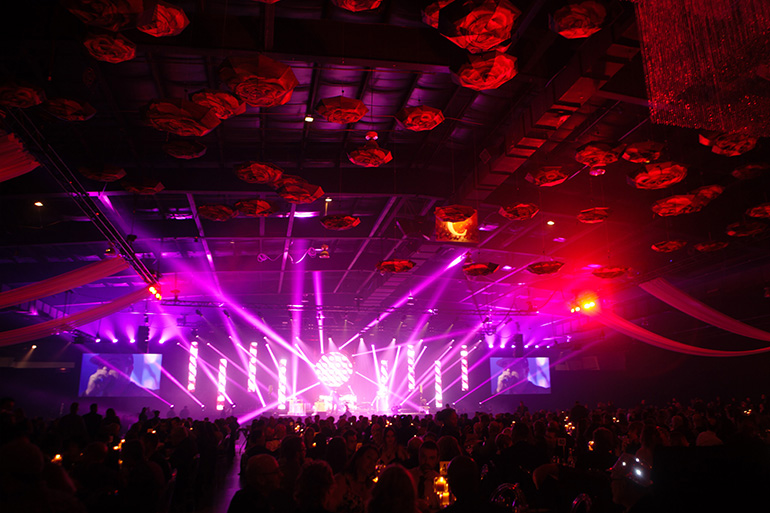
bb Blanc: circular LED panel display @ the 2016 Honda of Canada Manufacturing Holiday Party. Photo courtesy of The Taurus Group.
Imagine your guests entering the Piazza San Marco in Venice, one of the most famous squares in the world. Watch as they are mesmerized by the Byzantine architecture of St. Mark’s Basilica, its titanic bell tower and the Venetian lagoon. They walk by Harry’s bar, a swanky watering hole that hosted the likes of Ernest Hemmingway, Charlie Chaplin, Truman Capote and Alfred Hitchcock and hear the bustling sounds of the square. It is no longer in your imagination, this is now all possible and affordable. Projection mapping for those who are not familiar with the technology, is the ability to project objects on to surfaces. It can be as straightforward as projecting on screens or more complex like projecting interactive 3D displays onto buildings or industrial landscapes.
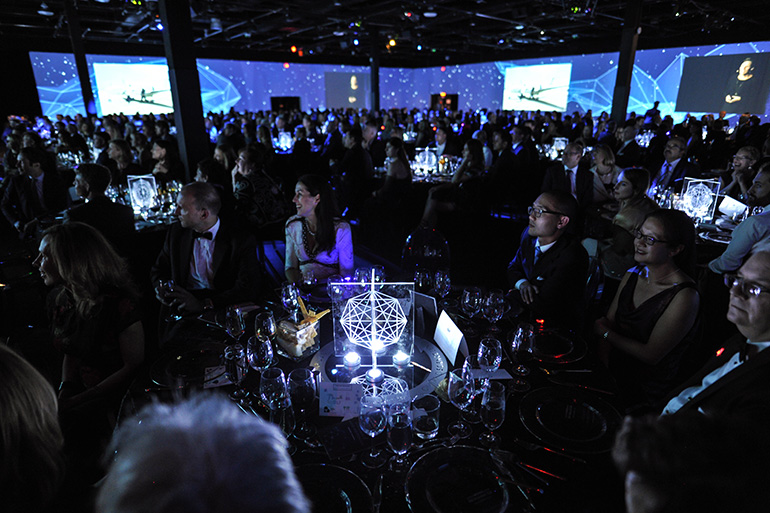
The Mustard Shop: full immersive projection @ the 2016 RBC Innovators’ Ball – Photo by Ryan Emberley Photography.
The 2016 RBC Innovators’ Ball (above) hosted is a good example of fully immersive projection.
Once cost prohibitive, advances are making this technology more accessible. 3D software is getting better, mapping is getting faster, projection is higher quality and you can pretty much project on to almost any surface including things like arenas, stadiums, cars, tables, runways, etc. You can even go floor to ceiling and wall to wall if you truly want to transport your guests to another world.
Two completely different examples are the Projection Mapping on the rink at the Colorado Avalanche’s hockey arena and the Target Fashion Show‘s use of the technology, both implemented by Westbury National.
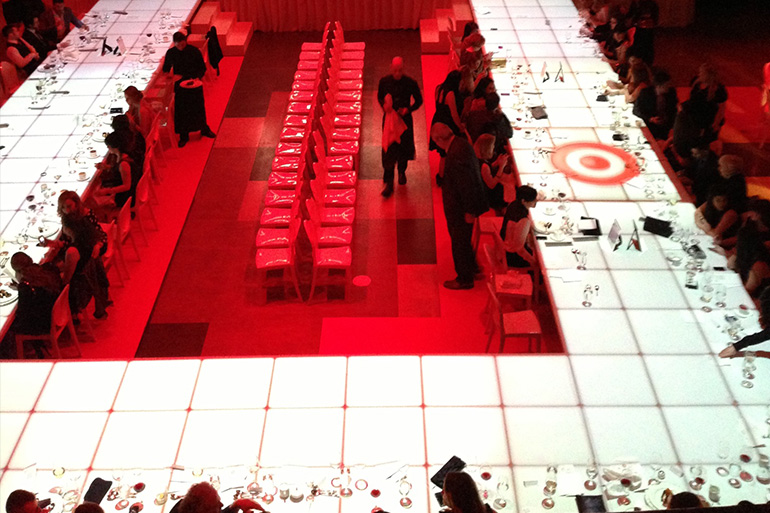
Westbury National: projection mapping @ the 4th Annual Target Toronto Fashion Incubator Fashion Show. Photo courtesy of Rob Sandolowich.
Before deciding to jump in and propose projection to your client or committee, here are some factors you will need to take into consideration and discuss with your client and service provider:
- Budget
- Size of venue space
- Theme/mood creation
- Content i.e. what are you projecting, the more complex the detail of the images the costlier it will be.
- Messaging—will you be using this technology to convey messages? For example are you connecting your guests to a cause in terms of a charitable gala?
- Time—you will need to give enough time in the planning process to maximize cost, creativity and collaboration.
- Audience size—take into consideration if it is an intimate affair or a gala for 1,000 guests.
- Ambient light—too much light i.e. windows or lighting from your LED screens can affect your projections.
- 2D vs 3D—3D is much more expensive and requires a lot more time and preparation. 2D can be just as impressive if you are strategic about the surfaces i.e. custom backdrop and locations that will benefit the effect.
Lighting is an easy and cost effective way to create ambiance. Up lighting & gobos can transform your room and create a dynamic feel. Light shows (moving light fixtures) can add excitement to your event or a great vibe for dancing or concerts. Pin lighting can be a great way to create drama and can transform centrepieces and decor elements into pieces of art.

Freeman Audio Visual: Lighting effects
Recently, I used fibre optic drape to create a starry like back drop which was complementary to a night under the stars theme. Not a new
technology, but Fibre Optic curtains are a trusted tool for creating feature lighting that provides a smooth yet spectacular colour changing effect which can be used for a variety of applications.
When it comes to projectors, HD Projectors are fairly common place today and cutting edge event producers are turning to 4K Ultra HD projectors but the question is whether there is real benefit to using 4K Ultra HD verses regular HD projection. 4K offers higher resolution; roughly 4X higher than regular HD, but they are still new to the marketplace and expensive to rent. In addition to better resolution, you are able to use one 4K projector as opposed stacking four HD projectors to create one large image that looks richer, sharper and less pixelated.
According to Joel Reodica of FMAV, “The advantage of this is that there is less work in terms of installation; however 4K projection mapping would require 4K motion/video graphics to match the resolution capacity, which means higher costs due to increased rendering times and file sizes. 4K content would also increase the capacity of the hardware-playback system or media server. Regular HD video equipment, transmission cables and projection hardware are not compatible with higher data rates and file sizes that 4K possesses. New 4K hardware is required.
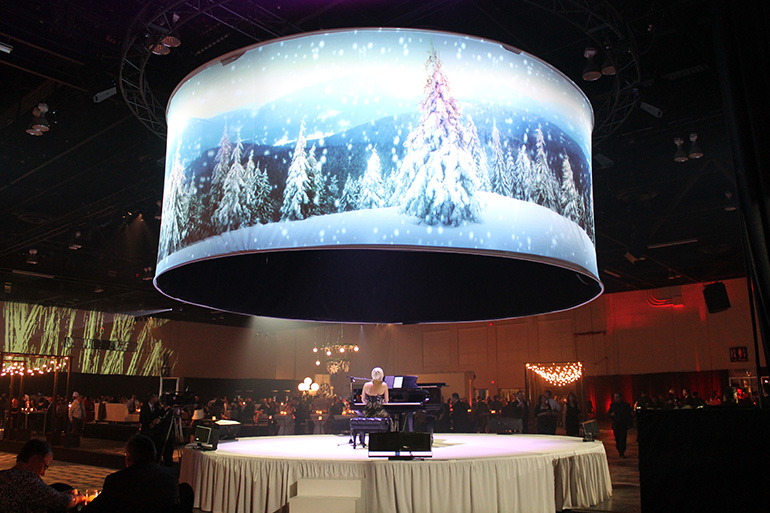
FMAV: projection @ the Cenovus Holiday Party.
3D software is getting better, mapping is getting faster, projection is higher quality and you can pretty much project onto almost any surface.
The cost of 4K may not cost 4X as much as using HD, but it will still introduce greater cost with potentially a much more compelling experience for the audience.”
Joel adds, “The alternative to 4K projection is to blend 4 or more HD projectors using a large blending system like a Spyder which is also costly.”
According to Josh Lovejoy of AV concepts, “4K makes sense for more unusual stage designs or intricate scenic elements that demand very precise projection mapping.” It all comes down to cost.
In terms of 4K Ultra HD verses LED, Lovejoy mentions advantages and disadvantages to both.
“LED’s biggest advantage is its effectiveness with ambient light. So, if you’re working in a space with a lot of natural light, like ballroom foyers, LED will likely be a better solution than projection. If your event is outside during the day, LED is essentially your only choice because projection is almost never powerful enough to compete with direct sunlight. If space is a real concern in your keynote or general session room, and you’re worried about the cone of projection, LED will also likely offer the advantage of significant space savings.
The biggest disadvantages of LED can be cost and image quality, as even the highest resolution LED screens often pale in comparison to the image quality of projection. LED is also generally much more expensive.”
Laser Projection is something that is in its infancy and cost prohibitive for most. It will provide unprecedented brightness, colour, and image quality and set the stage for the next generation of large-scale visual experiences. Giant screens, 3D cinema, theme parks, projection mapping and other colossal productions can now be scaled-up to previously unattainable levels, enabling the most memorable and impressive spectacles imaginable.
So how do the designers and technicians start the creative process when it comes to content creation? FMAV shared a video showcasing their creative process at work.
I asked Stephane Raymond, Creative Director for the award-winning Moment Factory where his team begins their creative process. They start with a client briefing to obtain key information including what kind of experience the client is looking for and what key messages do they want to deliver.
He says when they begin work on a project it is critical that the user interface (UI) and the User Experience (UX) are clear and easy to understand for the guests. The technology needs to be concealed so that the experience becomes magical. If you reveal how the trick is done; it ruins the mystique for the audience.
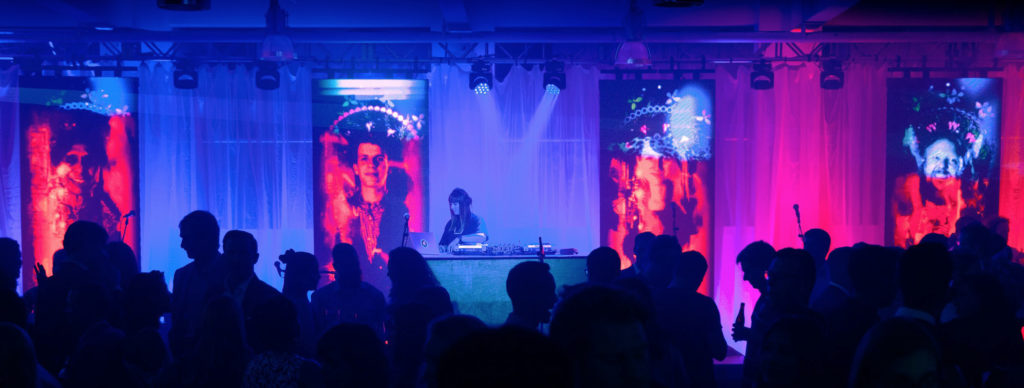
Guests’ portraits were used as principle scenographic content at the WWF Canada Pandamonium Doom & Bloom Fundraiser.
A perfect example of that magic in play is Moment Factory‘s WWF Canada Pandamonium Doom & Bloom Fundraiser (above) in Toronto. A mega red laser was synchronized with the separation between the “Doom” and the “Bloom” universe concept, creating a moving ceiling above guests’ heads. Participants’ portraits were also used as principle scenographic content, oscillating constantly between the “Doom” and “Bloom” version of their portrait. Another great example from Moment Factory’s past projects is Jean-Paul Gaultier’s exhibit at the Grand Palais in Paris in 2015.
Raymond also says that his team often uses lighting to enhance projection and when cost is a factor you can use it as a means to complete the projection. For example, if you are not able to afford multiple projectors to cover the entire mapping surface like a building, then he recommends using lighting as wall grazing/wall washing so you can create a more grandiose and complete experience. In addition, the use of sound and music plays an important part in the overall experience and should also be taken into consideration.
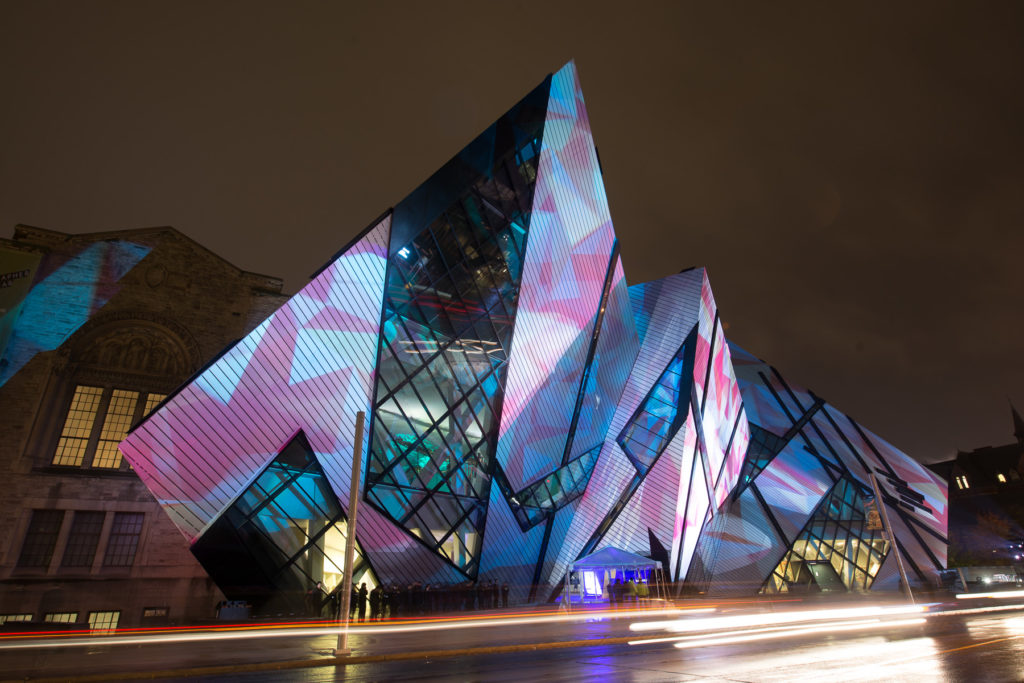
Projection Mapping on the Royal Ontario Museum
One way to keep content creation costs down is to us 2D as opposed to 3D projection which is mainly used for optical illusions. You can “trick” the illusion with a 2D image. It may not be as big or bold as 3D, but it is a viable option, especially when you project strategically. Another way to offset the budget is to use generative content production.
Wikipedia defines generative art as “art that in whole or in part has been created with the use of an autonomous system. An autonomous system in this context is generally one that is non-human and can independently determine features of artwork that would otherwise require decisions made directly by the artist. Generative art is often used to refer to algorithmic art (computer generated artwork that is algorithmically determined).”
As access and cost come down, we are going to see lighting and projection replace physical decor to some degree but don’t count out the need for decor designers. These tech advances only create more opportunities for collaboration between the traditional decor designers and projection content creators to make a seamless and powerful impact.
Thanks to the following event professionals for providing content and photos:
Brian T. Moore, The Mustard Shop
Clémence Foisy-Marquis, Karine Gagnon & Stephane Raymond, Moment Factory
Christian Millett & Madeleine Bart, Freeman Audio Visual
Jamie Richardson, Alissa Hurley & Joel Reodica, FMAV
Mike Agard, bb Blanc
Rob Sandolowich, Westbury National
Josh Lovejoy “4k Ultra HD vs HD Projection.”
This article was originally published in the June/July 2017 issue of Canadian Special Events Magazine.
Share
